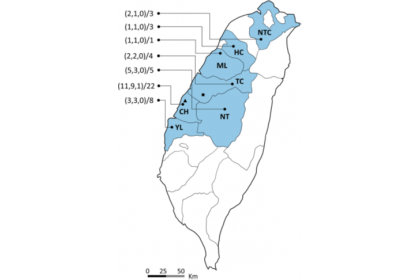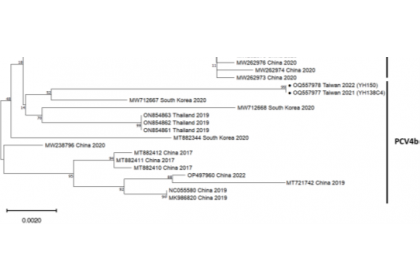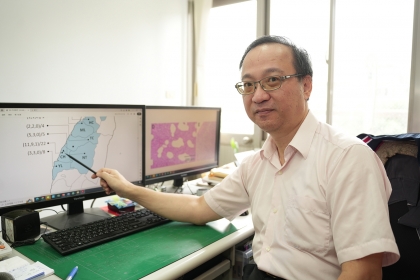Pig Research Team of National Chung Hsing University Discovered First Case of Porcine Circovirus Type 4 Infection and was Published in an Important Journal
2024-08-22
興新聞張貼者
Unit秘書室
1,440
In the 2000s, in Taiwan, the infection of pigs with the porcine circovirus type 2 (PCV2) caused significant losses to the pig industry. In 2019, China announced that the first porcine circovirus type 4 (PCV4) infection worldwide was discovered in Hunan Province. The pig disease research teams of National Chung Hsing University and Pingtung University of Science and Technology continued to monitor pig farms. We found the first PCV4 infection in December 2021 in Taiwan. The disease appeared in a pig farm in Changhua County, and the same PCV4 was detected again in the same pig farm in May 2022, confirming that PCV4 had entered Taiwan. This means our research on swine diseases keeps pace with the world, and the results were published in the influential "Cell Press" family journal " Heliyon " in August of this year (2024).
The research team includes Assistant Professor Cheng-Yao Yang and Director Hung-Yi Wu of the Graduate Institute of Veterinary Pathobiology, Professor Hung-Jen Liu of the Institute of Molecular Biology at National Chung Hsing University (NCHU), and Professor Ming-Tang Chiou and Director Chao-Nan of the Department of Veterinary Medicine at Pingtung University of Science and Technology (NPUST).
Assistant Professor Cheng-Yao Yang said that the significant pig infectious diseases had been gradually controlled, including preventing the invasion of African swine fever, foot-and-mouth disease-free without vaccination in Taiwan, Penghu and Mazu, classical swine fever vaccination has been removed for more than one year, and has been maintained disease-free status. The pig industry has gradually removed the risk of severe pig diseases. Subsequently, wasting diseases that cause pig growth retardation or reduce growth performance will become the focus of the pig industry in the future.
In 2019, the first PCV4 infection was discovered in China worldwide, and PCV4 cases were also found in South Korea and Thailand. Therefore, the swine disease research team of NCHU and NPUST has included PCV4 as an emerging infectious disease in pigs that requires attention during daily inspection. We found a positive PCV4 sample in 7-week-old nursery pig specimens sent from a pig farm in Changhua in December 2021. The examinations combined with molecular biology, phylogenetic analysis, and histopathological checks confirmed that it was the first case of PCV4 infection in Taiwan. In May 2022, the same PCV4 was detected again from the same pig farm sample. This confirms that PCV4 has entered and is present in Taiwanese pig farms.
In this case, Assistant Professor Cheng-Yao Yang explained that the sick pigs showed non-specific lesions such as weight loss, coughing, nasal discharge, and diarrhea, mainly in pigs between 6 and 10 weeks old. However, because respiratory pathogens such as Mycoplasmosis are also detected in sick pigs, it is difficult to distinguish whether PCV4 is the leading cause of disease in the case of mixed infection with multiple pathogens. However, the clinical symptoms and pathological changes of sick pigs are similar to PCV4 case reports from previous reports. However, currently, little is known about PCV4 infection. Research reports have proposed the extent of PCV4 disease, its role in compound infection, and its primary pathogenic mechanism. Conclusions that require continued and more research about PCV4.
Since the first case of PCV4 was reported in China, South Korea and Thailand have successively reported cases. Subsequently, Malaysia, Spain, the United States, and Taiwan have also discovered cases of PCV4 infection almost simultaneously. These countries use pigs as their primary source of animal protein. Researchers from various countries have also noticed that PCV4 has already impacted the pig industry.
In the past, a similar pathogen (PCV2) caused porcine multisystemic wasting syndrome in piglets, resulting in growth retardation or death from respiratory complex diseases. The nursery pig breeding rate dropped to 70%. This disaster was eliminated after the PCV2 vaccine was launched. However, in recent years, when vital pig infectious diseases have been controlled, the growth performance of pig farms has yet to achieve the same apparent progress. In addition to porcine reproductive and respiratory syndrome and porcine epidemic diarrhea that affects sows and piglets, the research team suspected that there are still undiscovered pathogens in pig farms (such as PCV4), becoming a hidden killer of poor growth performance.
For the pig industry, which is highly cost-effective, any wasting disease will cause various tangible and intangible losses. This time, through the cooperation of the Swine Disease Research Teams of NCHU and NPUST, emerging infectious diseases in pigs in my country were discovered, reminding the pig industry to start to be alert to the impact of PCV4 on pig health. The research teams will also continue to conduct more studies on the pathological changes and risks of PCV4 to reduce the losses caused by pig wasting diseases to the pig industry, promote pig feed efficiency, directly improve the productivity of the pig industry, and indirectly achieve the benefits of carbon emission reduction.
The research team includes Assistant Professor Cheng-Yao Yang and Director Hung-Yi Wu of the Graduate Institute of Veterinary Pathobiology, Professor Hung-Jen Liu of the Institute of Molecular Biology at National Chung Hsing University (NCHU), and Professor Ming-Tang Chiou and Director Chao-Nan of the Department of Veterinary Medicine at Pingtung University of Science and Technology (NPUST).
Assistant Professor Cheng-Yao Yang said that the significant pig infectious diseases had been gradually controlled, including preventing the invasion of African swine fever, foot-and-mouth disease-free without vaccination in Taiwan, Penghu and Mazu, classical swine fever vaccination has been removed for more than one year, and has been maintained disease-free status. The pig industry has gradually removed the risk of severe pig diseases. Subsequently, wasting diseases that cause pig growth retardation or reduce growth performance will become the focus of the pig industry in the future.
In 2019, the first PCV4 infection was discovered in China worldwide, and PCV4 cases were also found in South Korea and Thailand. Therefore, the swine disease research team of NCHU and NPUST has included PCV4 as an emerging infectious disease in pigs that requires attention during daily inspection. We found a positive PCV4 sample in 7-week-old nursery pig specimens sent from a pig farm in Changhua in December 2021. The examinations combined with molecular biology, phylogenetic analysis, and histopathological checks confirmed that it was the first case of PCV4 infection in Taiwan. In May 2022, the same PCV4 was detected again from the same pig farm sample. This confirms that PCV4 has entered and is present in Taiwanese pig farms.
In this case, Assistant Professor Cheng-Yao Yang explained that the sick pigs showed non-specific lesions such as weight loss, coughing, nasal discharge, and diarrhea, mainly in pigs between 6 and 10 weeks old. However, because respiratory pathogens such as Mycoplasmosis are also detected in sick pigs, it is difficult to distinguish whether PCV4 is the leading cause of disease in the case of mixed infection with multiple pathogens. However, the clinical symptoms and pathological changes of sick pigs are similar to PCV4 case reports from previous reports. However, currently, little is known about PCV4 infection. Research reports have proposed the extent of PCV4 disease, its role in compound infection, and its primary pathogenic mechanism. Conclusions that require continued and more research about PCV4.
Since the first case of PCV4 was reported in China, South Korea and Thailand have successively reported cases. Subsequently, Malaysia, Spain, the United States, and Taiwan have also discovered cases of PCV4 infection almost simultaneously. These countries use pigs as their primary source of animal protein. Researchers from various countries have also noticed that PCV4 has already impacted the pig industry.
In the past, a similar pathogen (PCV2) caused porcine multisystemic wasting syndrome in piglets, resulting in growth retardation or death from respiratory complex diseases. The nursery pig breeding rate dropped to 70%. This disaster was eliminated after the PCV2 vaccine was launched. However, in recent years, when vital pig infectious diseases have been controlled, the growth performance of pig farms has yet to achieve the same apparent progress. In addition to porcine reproductive and respiratory syndrome and porcine epidemic diarrhea that affects sows and piglets, the research team suspected that there are still undiscovered pathogens in pig farms (such as PCV4), becoming a hidden killer of poor growth performance.
For the pig industry, which is highly cost-effective, any wasting disease will cause various tangible and intangible losses. This time, through the cooperation of the Swine Disease Research Teams of NCHU and NPUST, emerging infectious diseases in pigs in my country were discovered, reminding the pig industry to start to be alert to the impact of PCV4 on pig health. The research teams will also continue to conduct more studies on the pathological changes and risks of PCV4 to reduce the losses caused by pig wasting diseases to the pig industry, promote pig feed efficiency, directly improve the productivity of the pig industry, and indirectly achieve the benefits of carbon emission reduction.




